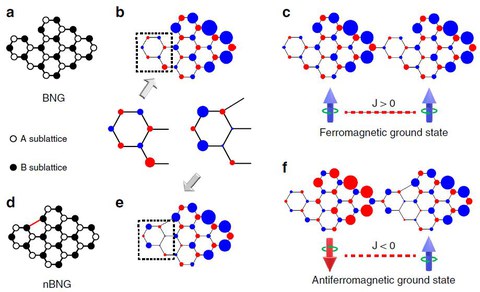18.01.2021
Designer Spin Order in Diradical Nanographenes
Researchers from the Chair of Molecular Functional Materials of Prof. Xinliang Feng, Technische Universität Dresden, and the research group of Jinfeng Jia, Condensed Matter Physcics, School of Physics and Astronomy Shanghai Jiao Tong University, recently reported the joint paper “Designer Spin Order in Diradical Nanographenes”. The magnetic properties of carbon materials are at the focus of research effort in physics, chemistry and materials science due to their potential applications in spintronics and quantum computing. Although the presence of spins in open-shell nanographenes has recently been confirmed, the ability to control magnetic coupling sign has remained elusive. Here, the researchers demonstrate an effective approach of engineering magnetic ground states in atomically precise open-shell bipartite/nonbipartite nanographenes using combined scanning probe techniques and mean-field Hubbard model calculations. The method provides opportunities for designer above-room-temperature magnetic phases and functionalities in graphene nanomaterials.
Reference:
Designer Spin Order in Diradical Nanographenes
Yuqiang Zheng, Can Li, Chengyang Xu, Doreen Beyer, Xinlei Yue, Yan Zhao, Guanyong Wang, Dandan Guan, Yaoyi Li, Hao Zheng, Canhua Liu, Junzhi Liu, Xiaoqun Wang, Weidong Luo, Xinliang Feng, Shiyong Wang Jinfeng Jia.
Nature Communications 11, Article number: 6076 (2020).
This work was financially supported by the National Natural Science Foundation of China (No. 11874258, 12074247) and Fok Yin Tung foundation. J.L. is grateful for the startup funding from the University of Hong Kong and the funding support from ITC to the SKL. This work is also supported by the Ministry of Science and Technology of China (Grants No. 2016YFA0301003, No. 2016YFA0300403), the National Natural Science Foundation of China (Grants No. 11521404, No. 11634009, No. 11574202, No. 11874256, No. 11790313, No. 11674226, No. U1632102, No. 11674222, No. U1632272 and No. 11861161003), and the Strategic Priority Research Program of Chinese Academy of Sciences (Grant No. XDB28000000). We acknowledge SJTU HPC center for providing computational resources.

